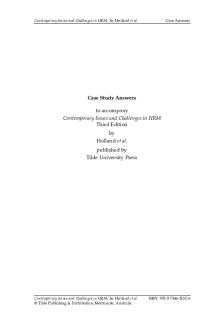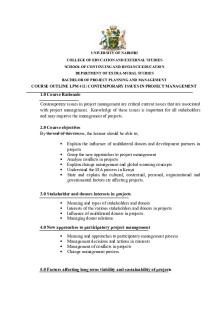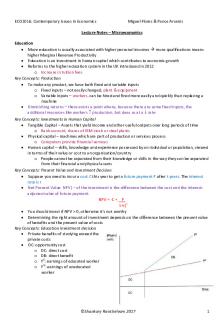OB13 Contemporary Issues in Leadership PDF

| Title | OB13 Contemporary Issues in Leadership |
|---|---|
| Author | Aziza Barek |
| Course | Organizational Behavior |
| Institution | Lebanese International University |
| Pages | 6 |
| File Size | 119.8 KB |
| File Type | |
| Total Downloads | 65 |
| Total Views | 140 |
Summary
important parts ...
Description
Chapter 13: Contemporary Issues in Leadership Framing is a way of communicating to create/modify/change meaning. Framing influences leadership behavior because it makes leaders capable of influencing how people comprehend, perceive and make meaning of different situations, people, events. Charismatic leadership There are four characteristics of charismatic leaders, as described by R.House: vision and articulation, personal risk, sensitivity to followers’ needs and unconventional behavior. Followers of charismatic leaders by observing leader’s behavior notice the leader’s abilities which distinguish him/her from other people, which are extraordinary and make the leader exceptional.
Born vs. made?
Many leaders are both with charisma, however, those were not charisma-gifted can be trained how to expose charismatic behaviors. There is even a 3 phase program of how to become a charismatic individual. First step is to develop charismatic thinking-attitude and acting. Secondly, individual creates relation with followers. Thirdly, individual ‘produces’ potential in followers by influencing their emotions.
Charismatic leaders and their influence on followers
Charismatic leaders do influence their followers, using 4-step process. First, a leader communicates attractive/interesting vision. Next, the first step is followed by vision statement, what is a formal expression of a company’s vision or mission. Then, the leader shows the modelled behavior, values, which are supposed to be examples for followers. Lastly, the charismatic leader influences followers’ emotions, usually by unconventional behavior; displaying courage and assurance of vision’s success and rightness. The most important element of a vision is its inspirational aspect and focus on the future. Moreover, the vision should adapt to reality and relevant events as well it should be challenging and realistic to achieve.
Charismatic leadership versus situational factors.
There are several relations:
Charismatic leaders influence high performance and high satisfaction among their followers. Organisations that have charismatic leaders make more profit Charismatic leaders affect people differently – people are more willing to follow a leader in a case of stress, disaster, emergence, crisis. Also people with low self-esteem are more likely to take leader’s direction.
However, despite those positive relations, there is reasonable assumption that charismatic leaders’ effectiveness depends on situation. The situational factors that enhance charismatic leaders’ effectiveness are the ideological components of followers’ tasks or high level of stress/uncertainty. In these situations, charismatic leaders are successful. The factors that limit charismatic leaders’ usefulness relate to the organizational context – lower level managers with charismatic qualities do not have a field of activity to demonstrate them.
Charismatic leadership: problems and disadvantages:
Charismatic leaders use their charisma for abusive actions: e.g. to increase their salaries, reposition their companies due to their image, blur the line between their interest and organization’s interest and use company’s resources for their personal benefit. They may be egodriven and then cause problems for organizations. There is a name for those leaders who are ambitious, driven, loyal and use these features to act in their organization’s interest, well-being rather than in their own interest. They are level-5 leaders. They have the 5 following qualities: individual capability, team spirit and skills, managerial competence, ability to motivate others and a mixture of humility and professional will. Transformational leadership Transformational vs. transactional leaders. Transactional leaders use conventional reward and punishment to gain compliance from their followers. They clarify employees’ roles, tasks requirements. They use management by exception: which seeks to minimize the opportunity for exceptions by enforcing defensive management processes (looking for deviations and intervention when standards are not met). Transactional leaders’ aspects: contingent rewards, management by exception and laissez-faire. Transformational leaders are those who inspire and get things done by injecting enthusiasm and energy. They have profound and outstanding effect on their followers. They provide a vision, communicate high expectation and promote intelligence, careful problem-solving and have belief in followers. They give followers personal attention and individual care. They are the inspiration; they are coaches, advisors, and listeners. Transformational leadership can be learnt. Transformational leaders’ aspects: idealized influence, inspirational motivation, intellectual stimulation and individual consideration. Assumptions about transformational leadership: o
Transformational leaders are more creative and encourage/promote creativity and innovativeness among their followers o Followers of transformational leaders are more ambitious in achieving goals and take personal interest in pursuing organizational goals o Vision is very important in mechanism of transformational leadership. It explains the effectiveness of transformational leadership
o
Transformational leaders make followers more committed to the organization; its strategy and make followers have more belief, trust in their leaders.
Transformational leadership can ‘boost’ impressive evidence for its effectiveness. Transformational leadership style generates more productive and satisfied followers-workers. But, there are also studies proving that contingent reward leadership is sometimes more effective than transformational leadership. There are debates about transformational leadership and charismatic leadership. Some researches use them interchangeably, some think that charisma is just one of a trait that transformational leaders have and that transformational leadership is broader than charismatic one. Nevertheless, studies show that leaders, who score high on charisma, score also high on transformational leadership.
Authentic leadership: ethics and trust as fundamentals of leadership Authentic leaders are those who know who they are, act openly and accordingly to their beliefs and values, are honest with themselves and with the followers, are considered as ethical. Their main advantage and virtue is trust. Authentic leaders build trust on their transparency – they value information sharing and communicate messages reflecting their values, beliefs, norms, ideals. Authentic leadership, unlike other leadership styles, focus on the moral side of leadership. The topic of ethics in leadership is getting more and more attention. There are several reasons for that. First, there is a general trend towards ethical shift in management. Moreover, bibliographies of famous leaders revealed their unethical behaviors. Moreover, the relations between leaders and their ethical behavior are crucial. Unethical leaders abuse their power, position to achieve self-serving goals. Ethical leaders, however use their power and charisma for the benefit of society or a group. The notion of socialised charismatic leadership has recently emerged as a leadership style that is non-exploitative and motivates followers to maximize the gains of the organization without regard for the leader's personal needs. Those leaders demonstrate other- centred attitude rather than self-centred.
Trust Trust is a relationship of reliance, it is the expectation that another party will not behave opportunistically. The notion implies willingness to take risk and familiarity. There are however other trust dimensions to be mentioned: integrity (the most important), competence, consistency,
loyalty and openness. Trust is crucial in leadership. It is the fundamental on which leader builds his/her image and identity. There are 3 types of trust: 1) Deterrence-based trust – trust is based on fear or reprisal in the trust is abused (most fragile type, most new relationships are based on it, punishment as a result of trust violation). Example: new manager-employee relationship. 2) Knowledge-based trust – trust based on the predictability of behaviors, this predictability is built on past relations, experiences. It relies on information. In this trust type, predictability builds trust, if you are able to predict person’s behavior, then you trust him/her more. Most relations in organisations are based on this trust type. Example: manager-employee relationship 3) Identification-based trust – trust based on emotional connection between the parties, on mutual understanding, on knowing what the other party wants, expects, appreciates. Exists loyalty between parties and minimum level of control is imposed. Example: marriage. There are also principles of trust:
Mistrust drives out trust Trust begets trust Trust can be regained Mistrusting groups self-destruct Mistrust lowers productivity
Contemporary Leaders Mentoring A mentor is a person from the higher-level management who takes the position of sponsor and supervisor for the less-experienced employee (protégé). Mentoring is based on career and psychological function. Some firms have official mentoring programs, some have informal mentoring. Mentoring is beneficial for mentor, protégé and the whole organization. The main benefits for mentor include the access to what lower-level employees think, feel and thanks to that it also gives possibility to sense potential problems. There is a tendency to select protégé basing on his/her similarities with the mentor. Nevertheless, although mentoring approach serves many functions, most of its outcomes emphasize psychological benefits rather than material.
Self-leadership
Its main assumption proposes that individuals, by controlling their actions, can develop leadership behaviors and qualities. The importance of self-leadership goes along with the importance of team creation. Teams need self-directed people.
Online leadership There has only been little research on this leadership type. It’s important to remember that words, sent digitally, can also (de)motivate. Good online leaders need to carefully select words, “read between the lines”, and learn how to make messages transmit trust, status, warmth, motivation. They also need to think about the actions that need to follow the message on the employee’s side. The main challenge of online leaders is to build and maintain trust.
Challenges to the leadership construct There are 2 assumptions that challenge the importance of leadership (leadership not being necessary): 1. Attribution theory of leadership -> this theory states that leadership is one of the attributions that people make about others, to explain social events. People simply associate leaders certain with characteristics and when they meet individual representing these characteristics, they take him/her for leader. In organizations, people explain organizational situations by attribution theory, e.g. high profit is explained by having a good leader. By appearing as a good leader, others can view you as one, even if you lack actual accomplishments. 2. Substitutes for and neutralizers of leadership -> some people think that there are substitutes for leadership and neutralisers of leaders’ influence on others. The substitutes make leaders’ activities unnecessary, while neutralisers negate leaders’ effectiveness and influence. This theory is however under controversy, as there are many problems with applying the theory of substitutes and neutralisers and the difference between these two notions are sometimes blurred.
Finding and creating effective leaders:
Selecting leaders – analysis of situation a company faces, helps to find what kind of leader is needed. Tests as well as interviews may help to identify a leader. Moreover, companies should plan/prepare for leadership changes. Training leaders – there are a few things managers can do to enhance the training outcomes. Leaders high in self-monitoring benefit from training more. Leaders can be even more effective is they are taught how to implement skills, build trust, mentor, recognise situational contexts and cope with them. Moreover, research has shown that
charismatic leadership qualities can be enhanced by behavioral training using modelling. Also, transformational leadership skills can be taught.
Global consequences: Transformational/charismatic leadership style works around the globe. There are some universal dimensions of leadership e.g. leaders’ vision, foresight, motivating skills, trust, proactivity, dynamism. However, cultural differences and leadership type adaptation are also important. Globalisation made the leadership style more universal....
Similar Free PDFs

Contemporary Issues
- 18 Pages

LPM 411- Contemporary Issues
- 2 Pages

Contemporary Nutrition Issues notes
- 18 Pages
Popular Institutions
- Tinajero National High School - Annex
- Politeknik Caltex Riau
- Yokohama City University
- SGT University
- University of Al-Qadisiyah
- Divine Word College of Vigan
- Techniek College Rotterdam
- Universidade de Santiago
- Universiti Teknologi MARA Cawangan Johor Kampus Pasir Gudang
- Poltekkes Kemenkes Yogyakarta
- Baguio City National High School
- Colegio san marcos
- preparatoria uno
- Centro de Bachillerato Tecnológico Industrial y de Servicios No. 107
- Dalian Maritime University
- Quang Trung Secondary School
- Colegio Tecnológico en Informática
- Corporación Regional de Educación Superior
- Grupo CEDVA
- Dar Al Uloom University
- Centro de Estudios Preuniversitarios de la Universidad Nacional de Ingeniería
- 上智大学
- Aakash International School, Nuna Majara
- San Felipe Neri Catholic School
- Kang Chiao International School - New Taipei City
- Misamis Occidental National High School
- Institución Educativa Escuela Normal Juan Ladrilleros
- Kolehiyo ng Pantukan
- Batanes State College
- Instituto Continental
- Sekolah Menengah Kejuruan Kesehatan Kaltara (Tarakan)
- Colegio de La Inmaculada Concepcion - Cebu












